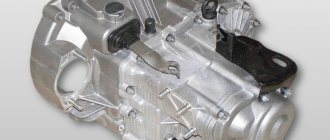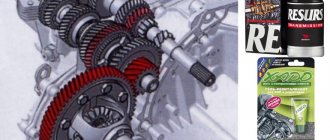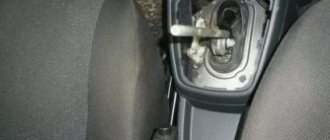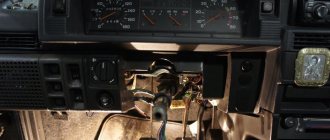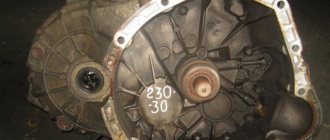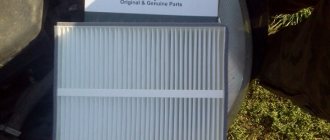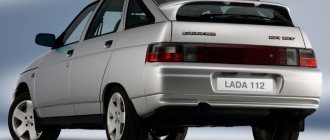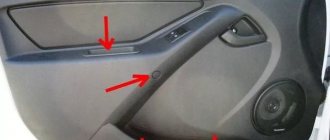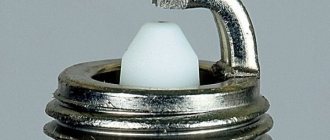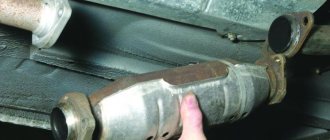The gearbox is the main unit after the engine. The Priora manual transmission is a reliable, modernized unit from 2110. The Priora's mechanics are filled with 3 to 3.5 liters of oil. Russian cars are chosen for their relative reliability, cheap spare parts, and endurance. If we take the manual transmission, then this is a reliable, unpretentious unit - although the box howls in 2nd gear, even when the car is new. The sales leader from 2012 to 2016 was the Lada Priora, especially in the Caucasus and CIS countries. It is well equipped and has decent technical characteristics. Since 2014, it has been possible to find cars equipped with an automatic transmission. The weakest Priora engine has a power of 87 horsepower, depending on the body type. The initial configuration of the Priora is a 1.6-liter eight-valve engine. It is equipped with a manual transmission.
Characteristics of the Lada Priora gearbox
The base of the gearbox is represented by the following units:
- Clutch housing;
- Transmission housing;
- Rear transmission starter flap.
All elements are connected to each other with fixing nuts and sealant. The design is protected from contamination by means of a magnet that retains waste metal products. The main shaft is a set of gears that, when rotated, are connected to additional gears of all speed modes. The additional shaft is designed to regulate and distribute the oil emulsion.
There are two types of bearings installed on the gearbox shafts: ball bearings in front, roller bearings in the rear. In order to connect with the outside atmosphere, a breather is provided. It is located at the top of the node.
The AvtoVAZ model has two types of transmission: controlled by traction or cables. The mechanism of action and design of both options are radically different from each other.
Made with German precision
When this concept was transferred from paper to a real exhibit, and the mechanism began to work correctly, the module went to Germany, to. The Germans brought the knot to fruition. The company has long been developing various transmission systems and manufacturing engines. German experts carefully looked at the development of Russian engineers and proposed the following. Using a 3D center plate instead of a locking spring return system would make more sense. The special spatial shape of this plate was calculated using computer programs and manufactured using high-precision equipment. This accuracy is due to the fact that a special locking ball moves along the plate. And it is the plate that regulates the effort when selecting and engaging gears. The characteristics that the new cable gearbox will have were selected using a simulation stand. The man sat down on a chair and switched on various gears. Automatic systems simulate shift patterns, lever forces and strokes. And just like that, in small steps, the Germans managed to find the optimal settings. With the help of a computer, parameters and a mathematical model were selected, according to which these plates would then be manufactured.
All the details of the box - what's inside
The five-speed gearbox of the Lada Priora is connected to the central gear and differential. The Priora gearbox consists of shafts: the input shaft is made as a block of central gears. The gears of the forward speed modes have oblique teeth, the reverse gears have straight teeth. They contact the gears of the secondary shaft. There is an oil sump at the bottom of the secondary shaft in the bearing area. It is responsible for distributing the oil emulsion and supplying it to the secondary shaft, and then to the driven gears of all gears. The design of the gearbox includes a gear synchronizer. Synchronizers for 3rd, 4th, 5th gears have a similar design. The only difference is the blocking circles. The parts of 1st and 2nd gears have a different design. They have two cone-shaped friction areas installed, which relieve the load, distributing it evenly among themselves.
There is a magnet in the core of the clutch housing. It attracts metal waste and shavings and prevents its penetration into the system. A mandatory element of the box is the drive. It should be treated with special care. In addition to the listed parts of the box, it contains a jet rod, which is fixed at one end to the motor. Thanks to this, independent gear changes while driving are excluded.
The traction-controlled transmission has a three-arm handrail that activates the selected speed mode. A cable-operated transmission has a cable that activates the desired gear.
Cable drive
At AvtoVAZ they decided to abandon the traction drive entirely, even despite the maximum simplicity and low cost of the system. Almost all automakers have long abandoned rods. A cable-driven gearbox was first introduced as an experiment at Samara. Then the components were purchased from Morse. However, that gearbox had a lower location of the shift mechanism, which made the use of cables quite problematic, frightening engineers and cost. The project was not closed, and the serial updated cable-driven gearbox appeared only recently.
Lada Priora gearbox malfunctions and ways to eliminate them
Like any car component, the gearbox is subject to the negative effects of external destructive factors. The Lada Priora gearbox can also break down. The nature and frequency of breakdowns is influenced by management style, operating conditions, timeliness of maintenance, and quality of care. The manufacturer recommends changing the lubricant every 60,000 - 70,000 kilometers. The quality and correct choice of substance also affect the service life. Conventionally, all problems with a node are usually divided into two large categories: problems with the node itself or its mechanism.
The main types of faults are shown in the table:
| Problems with the node itself | Mechanism problems |
| Gear wear | Drive rod malfunction |
| Failure of synchronizer clutches | The rod does not function, there is play |
| Spline message | Damage to the locking device |
| Reduced oil level | Roller wear |
| Liquid leak | |
| Bearing wear | |
| Deformation of oil seals | |
| Wear of the gearbox cushion |
There are a number of main reasons contributing to the breakdown.
Gear selection mechanism.
Priora and Kalina cars use the VAZ 1119 gear selection mechanism, this is a modernized ten-wheel mechanism. It has a stronger lever, a wider spring, and overall the mechanism is more reliable.
But as you can see in the photo, this does not mean that it has stopped breaking. As a rule, it cannot be repaired and requires replacement as an assembly.
Factors causing defects and breakdowns:
- Operating the vehicle improperly. Untimely maintenance, untimely oil change, insufficient quantity, operation of a vehicle with a faulty clutch;
- Poor quality parts of the unit;
- Operating a vehicle with worn-out parts or failing to replace them in a timely manner;
- Irrational replacement of parts performed by unqualified specialists.
The driver may suspect a faulty Lada Priora gearbox when symptoms appear.
At what speed should you change gears - on a motorcycle, Priora, engine, diesel, Sense
Why is this maximum torque indicator needed? And it is needed so that at the maximum torque value, the best period begins for switching to a higher gear. If you spin the engine to higher speeds, then its resource will be exhausted much earlier than provided by the manufacturer.
"A special case"
When accelerating on a steep incline, switching should be done a little later than usual, since while driving with the transmission disengaged (with the clutch depressed), the car will have time to lose more speed than on flat terrain or a gentle incline.
Signs of a box malfunction:
- The first gear is engaged with effort.
- Switching occurs uncontrollably.
- The car jerks while driving.
- Transmissions are not included.
- The presence of uncharacteristic sounds when switching modes: creaks, crackling, grinding.
- Oil is leaking.
- The car vibrates when driving.
- The noise of the box when the engine is running, which disappears after the clutch is depressed.
It is problematic to accurately determine the nature of the breakdown, since the same sign may indicate different defects. To determine the breakdown, disassembly of the unit is necessary. Often the reason lies in adhesion, as these two elements are inextricably linked to each other.
To troubleshoot problems, it is necessary to dismantle the Lada Priora gearbox, replace worn parts, oil, and adjust the gaps.
How was the transmission created?
The new gearbox system is based on the previous design, which is familiar to many from the VAZ-2108. Naturally, the engineers made minor improvements. The weaknesses of this box are also well known to all owners of VAZ cars. Thus, among the weak points, many highlight difficulties when shifting gears, large shift lever strokes, a rather smeared shift pattern, and vibrations during operation.
Gear ratios for manual transmission of Lada Priora
Gear ratios are one of the characteristics of the gearbox of any car. The term refers to the ratio of the number of teeth of the two gears of the main and accessory shafts, which come into contact with each other during rotation. If the gear of the first shaft has a smaller number of teeth compared to the gear of the second shaft, then the output speed decreases and the force thrust increases, and vice versa.
Gear ratios
| Broadcast | Meaning |
| 1 | 3.64 |
| 2 | 1.95 |
| 3 | 1.36 |
| 4 | 0.94 |
| 5 | 0.78 |
| Reverse | 3.50 |
| main gear | 3.70 |
Assembly of the secondary shaft.
We assemble the secondary shaft in the reverse order of disassembly. In this case, you should pay attention to the following points. If you removed the coupling from the hub, then put it back together; to do this, use a screwdriver to insert a cracker so that it ends up between the hub and the coupling as shown in the photo. We orient the coupling so that the ball is opposite the groove in the coupling during assembly. Usually, when disassembling, it is recommended to mark the coupling with the hub so that it can be reassembled in the same way as it was before. If you haven’t marked it, then in general there won’t be anything wrong with it.
Please note that the reverse gear ring must be positioned upward. The locking ring is copper plated and has a larger diameter. Do not confuse it with what is installed after the 3rd-4th gear hub.
When assembling, orient the synchronizers so that their protrusions are located opposite the coupling nuts:
The thinner washers are placed first, immediately on the 4th gear gear, then the bearing, then the thick washer.
Subsequence:
- Using a size 8 wrench, unscrew the nut of the drive housing. Disconnect the cable from the clutch pedal retainer.
- Remove the compensation system box and ring from the pedal. To avoid damage, carefully pick out the box with a knife.
- Remove the plastic sleeve from the pin. If there are signs of damage, replace with a new one. Lithol treatment is required before installation.
- Remove the drive seal from the hole in the front of the shield.
- Remove the tip, first dragging it in the direction of movement of the car.
- Unscrew the cable end fixing nut. It is screwed onto a bracket, which is attached to the transmission with a 17-point head.
- After removing the tip, pull out the cable.
- Unfasten the latch and remove the speed sensor chip.
- Unscrew the fixing screws of the pallet flap and remove it.
- Secure the engine with a reliable support.
- Unscrew the fixing bolt of the rear engine mount to the bracket.
- Remove the limiter on the rear surface of the motor.
- Unscrew the bolts that secure the motor to the body surface.
- Remove the support from the rear side.
- Remove the limit rollers from below.
- Unscrew the motor bracket clamps on the rear surface of the transmission housing.
- Using a size 8 wrench, unscrew the top screw and remove the bracket.
- Unscrew the screw and remove the speed sensor chip.
- We unscrew the bolt securing the gearbox hinge box.
- Remove the click rod from the hinge base.
- Loosen the torque clamps.
- Remove the designer hubcaps from the front wheelbase.
- Using a knife to pick up the edge, remove the hub protective lining.
- Align the hub nuts.
- Loosen the screws securing the wheelbase. Using a 30mm socket, unscrew the hub bolt.
- When you unscrew the screws that secure the wheelbase, the car is positioned on the platform with all wheels.
- To prevent the vehicle from moving, tighten the handbrake and install supports under the rear wheels.
- Unscrew the ball joint clamps and remove the maneuvering knuckles.
- Remove the shank from the hub.
- After removing the left drive, put a plug in its place.
- Press out the drive on the right side. Remove it.
- Place a support under the transmission.
- Remove the screws securing the transmission to the engine.
- Move the gearbox as far back as possible, remove the support, holding it.
The transmission of AvtoVAZ models has the advantage of simplicity of design and the ability to install it yourself if you have the necessary skills.
How to correctly shift from 1st to 2nd gear? (Lada XRAY)
I just can’t get the hang of shifting manual transmission gears from 1st to 2nd without jerking. (Engine 1.8). When switching smoothly at 1800-2021 engine speeds, the car loses speed and begins to twitch during acceleration. If you spin the engine harder (2500-2800 revolutions), then after releasing the clutch pedal the car nods (the effect of engine braking).
Lada (“Lada”) is a brand of cars produced by AvtoVAZ JSC. Previously, it was used only for export cars, and for the domestic market, cars were produced under the Zhiguli brand. In 2021, the management of AvtoVAZ announced the transition to the Latin alphabet for the official spelling of the names of all cars produced by the plant: Lada - instead of "VAZ" and "Lada".
